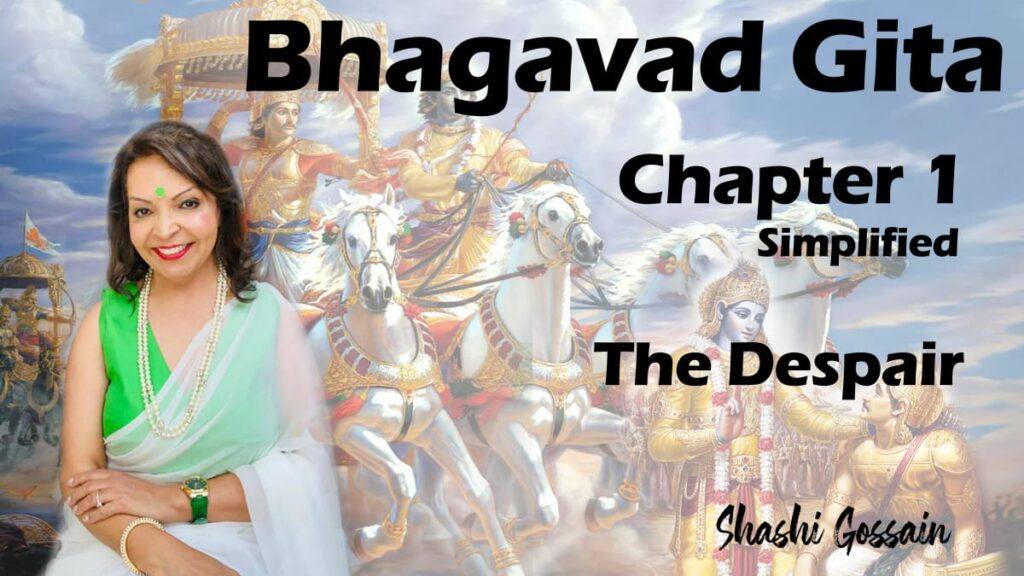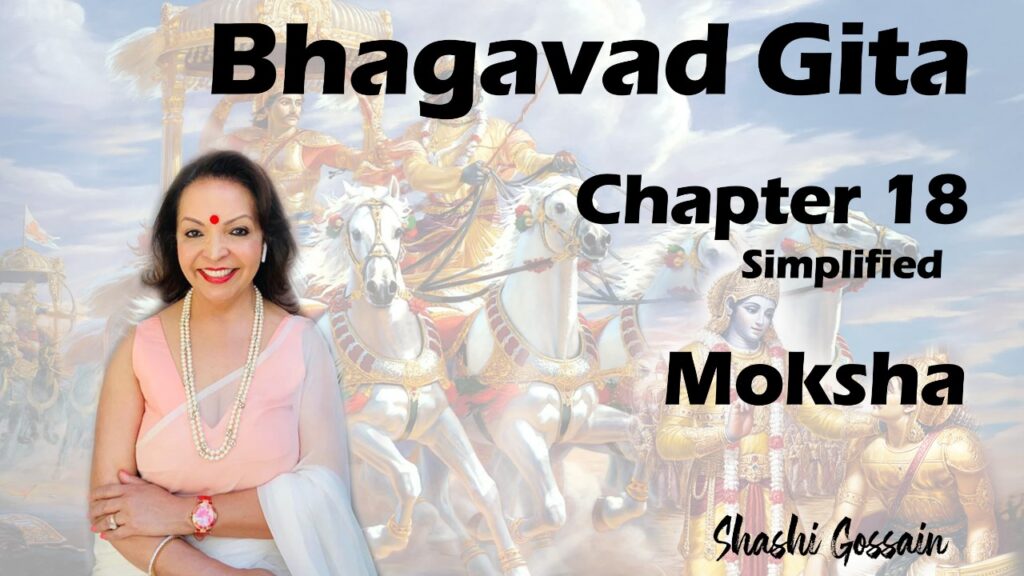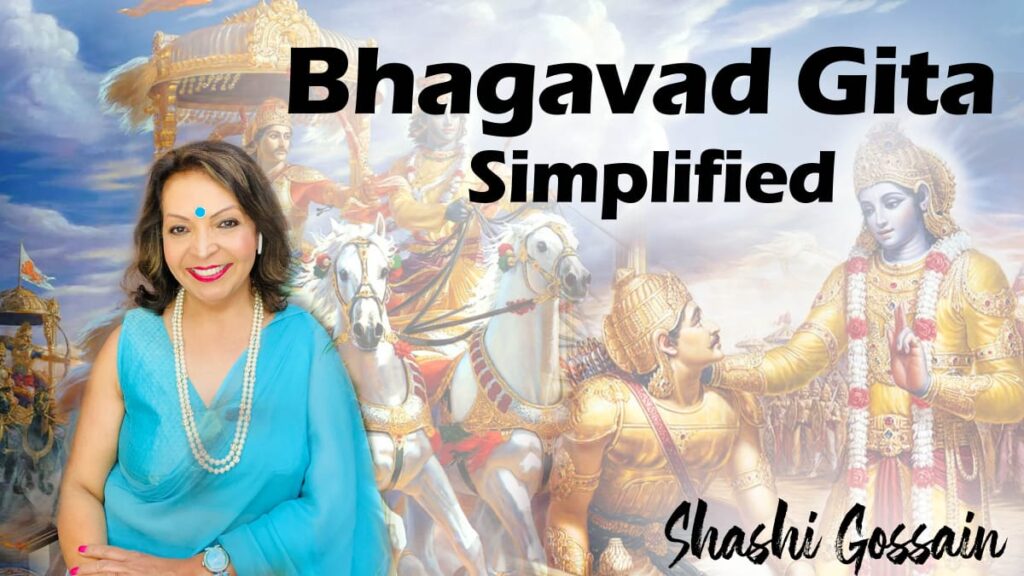Summary and Analysis of Chapter 1 of Gita
The setup in which the Geeta-teaching is imparted is the epic battle of Mahābhārata, fought between the Pāṇḍavas (Arjun and his brothers) and Kauravas (100 sons of Dhritrashtra).
Let us first understand why did Mahabharata war happened in Kurukshetra?
After completing the exile, The Pandavas (Arjun & his brothers) have come to take back the kingdom from the care taker King Dhritarashtra, who wants to give it his son Duryodhana, even though the crown rightfully belongs to Arjun’s eldest brother, Yudhishthira.
The Pandavs are upholding dharma, the duty to rule their kingdom, & their cousins, Kauravas, who use deceit and other forms of treachery to maintain power.
What is the first chapter of Bhagavad Gita?
The story begins with the battle lines drawn between the armies of the warring cousins.
The blind king Dhritarashtra asks Sanjay, who has the ability to see all, to tell him about the battle between his family. Sanjay told him:
Prince Duroydhana, looks very confident of winning. He approaches his teacher Dronacharya, and lists out the key members of each side. He notes that his own army is immense, while the Pandavas is much smaller.
Each side blows their divine conchs, signalling the war is about to begin.
Till now Arjun was convinced that his cousins are unrighteous, and he, as a kṣatriya, has to fight the battle to establish righteousness.
He has Shri Krishna drive his chariot out into the middle of the field between the two armies.
The schemimg Lord Shri Krishna brings the chariot in front of Bhīṣma and Droṇa and asks Arjun to survey the army.
Why does Arjuna not want to fight?
Arjuna, facing the reality of killing his cousins and family friends, throws up his hands in despair.
Arjun is overcome with grief & despair and tells Shri Krishna that he has no desire to fight if it means killing his kin. He has no need for a kingdom if it means destroying a family. He casts away his bow and arrows and sits in the chariot in the middle of the battlefield.
Who told Gita to whom?
Although set in a battlefield, the discourse of Shrimad Bhagavad Geeta, is essentially a two-person conversation about philosophy and yogic principles, as opposed to a treatise of battle.
Shri Krishna, as the divine voice of yoga, dharma, and karma, must not only convince Arjun to fight, but to fight with the will to win, to restore good, to restore balance, to fulfil his duty as a warrior.
In the process of convincing him, Krishna will lay out essentially a philosophy for living, and the basic tenets of Hinduism.
What is Krishna’s message to Arjuna?
Shri Krishna tells Arjun to arise with a brave heart and push forward to destroy the enemy. Krishna says there is no such thing as the killer and the killed, that the body is merely flesh, and that at the time of death he attains another body. These limits of the superficial body should not stop someone from doing what he must do, namely defeating evil and restoring the power of good. If he shirks from this battle, however, then Arjuna will incur sin, violating his dharma and his honor. Krishna also extols the notion of yoga as a path towards finding focus. He encourages Arjuna to not see the results of action, but rather focus on the work itself, without attachments, to treat success and defeat the same. When a man is unmoved by the confusion of ideas, he can attain perfect yoga. Arjuna asks how a man acts when he has achieved perfect yoga. What does he look like? Krishna says this kind of man is not agitated by negative emotions, lust, fear, anger. He finds peace in the work, peace in the universe because he has found himself. These men are naturally meditative and do not respond to good or bad fortune, life or death. They have no attachment to the material world. They are free from ego, the ‘I, me, mine’ which cause pain.
What is a basic teaching of the Bhagavad Gita?
Teaching in chapter 1:
- One identifies, the problem, saṃsāra
- Have sincere longing for freedom from saṃsāra.
- Seek guidance from a guru
There are 3 types of problems, saṃsāra:
- attachment (kṛpā)
- grief (śoka)
- delusion (moha)
When one is not happy with oneself, one has to seek external aids, dependence, and attachment, leading to a troubled mind. Naturally, Arjuna is overpowered by attachment, then follow the twin offshoots of attachment i.e. grief and delusion The message of the first chapter of the Gita is that The root cause of all sorrow and suffering in this world is our inability to deal with conflict. That is why the Gita was taught to Arjuna in the middle of a gruesome battlefield, with swords clanging, trumpets roaring, and soldiers screaming. Conflict is everywhere, and we have to learn to handle it. The sooner we recognize this universal truth about conflict and its impact, the sooner we can progress in our personal, professional, and ultimately, spiritual journeys. We experience conflict at three levels-
Material: disagreements with children, siblings, spouses, bosses
Mental: turmoil in our minds, between the rational side & our ego. We have conflicting arguments about our actions.
Spiritual: we are confused about who we are, what God is, and what our connection to that God is.
What was the major dilemma for Arjuna in the Bhagavad Gita?
Material dilemma of Arjun: conflict of battle.
Mental dilemma: Arjuna’s mind became conflicted when he saw his family on the enemy side. Should I kill my family? Or should I perform my duty?
The inability to reconcile this conflict in his mind led to his mental breakdown in the middle of the battlefield. He could not commit to fighting, and being unable to decide, he wanted to quit.
What’s unique about the Gita is its perspective on how we should deal these two levels of conflict.
The clue lies in verses 21 and 22, where Shri Krishna positions Arjuna literally in the middle of the two armies, a point from which Arjuna can see his dearest teachers and relatives stationed on the other side of the battlefield.
This immediately triggers the third type of conflict that of identity. Arjuna now thinks:
Who am I?
Am I the warrior fighting for a just cause?
Or am I the beloved student of my teacher?
If I am that warrior, I should be in the Pandava army. And if I am that beloved student and relative, I should be in the Kaurava army.
But I am both, So what should I do?
Since I don’t know how to reconcile my identity, easiest option is to quit.
Quitting is the default response of the ego.
In his speech to Shri Krishna, Arjuna used logic to justify his quitting the battle.
This is what many of us do, we run away from our conflicts, and use logic, fate, destiny, or any excuse, to justify our quitting to ourselves. The spiritual conflict is the confusion of identity.
Unless we know who we are, what God is, and what our connection to that God is, we will never be able to completely resolve all our material, mental & spiritual conflicts. This is the central theme of the first chapter.
The second chapter contains Shri Krishna’s response to Arjuna’s misguided speech and a summary of the entire Gita.
It addresses how to deal with all three types of conflicts so that we can put an end to sorrow and anxiety at their root.




Pingback: Bhagavad Gita Chapter 2: The Enquiry - Simple Hinduism